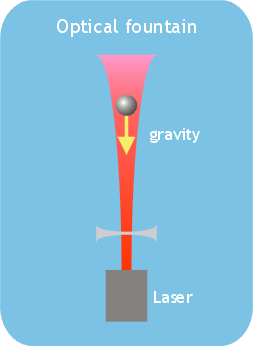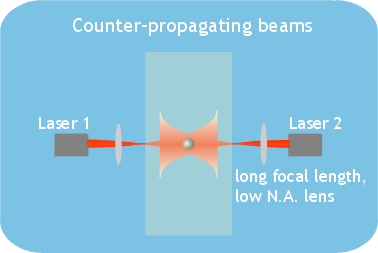| |
Contents | EBJ Home | Single molecule measurements and biological motors |
Several different trap geometries have been used over the years; the three most common types of trap are illustrated below. The optical fountain, to the best of our knowledge, has not found any biological applications. The dual beam trap is used by some researchers for specialised applications (see Smith, Cui and Bustamante (1996) for an example). Most trapping work is done with the single beam gradient trap, which is what is usually referred to as an optical tweezers.
 The optical fountain (Ashkin and
Dziedzic, 1971) allows particles to be suspended in mid-air at the point
where the optical scattering forces are balanced by gravity.
The optical fountain (Ashkin and
Dziedzic, 1971) allows particles to be suspended in mid-air at the point
where the optical scattering forces are balanced by gravity. |
 Counter-propagating
beams (Ashkin, 1970; Smith,
Cui and Bustamante (1996)) produce a point in space where the scattering
force produced by the left (Laser 1) and right (Laser 2) laser beams cancel.
Both lasers contribute to lateral stability and give a three dimensional
trap of very high stiffness; however, this configuration is rather awkward
to align and to steer. Counter-propagating
beams (Ashkin, 1970; Smith,
Cui and Bustamante (1996)) produce a point in space where the scattering
force produced by the left (Laser 1) and right (Laser 2) laser beams cancel.
Both lasers contribute to lateral stability and give a three dimensional
trap of very high stiffness; however, this configuration is rather awkward
to align and to steer. |
|
Rotational control of the object can also be effected by using a circularly polarised laser beam with a toroidal beam profile - what is known as an “Optical Spanner” (Simpson et al., 1997) |
| Contents | Next |